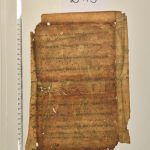In terms of the notation, it is certainly a Hungarian source, characterized by long entry lines for the puncta, elongated horizontal elements (e.g. clivis), attached double puncta in the climacus. The chants registered may be surplus responsories for the third nocturn of commune plurimorum martyrum Matins, which is an archaism considering the Hungarian tradition: these chants in this position could not be found in Hungarian sources yet. In the Antiphonale Codex Albensis from the 12th century – Graz, Universitätsbibliothek, Ms. 211 – the Exultabunt appears in the office commune plurimorum confessorum. Cf. László Mezey–Zoltán Falvy (ed.), Codex Albensis. Ein Antiphonar aus dem 12. Jahrhundert. Monumenta Hungariae Musica 1. Budapest: Akadémiai Kiadó, 1963.
The melody of the antiphon Voce mea is corrupted on the fragment. The chant usually notated in mode 7 is transposed to F (with the psalm difference also transposed a whole-tone lower), however, the final part remains on G, making the transposition senseless.
Gabriella Gilányi, Zsuzsa Czagány



